Symbolic Representation of the Snake
|
|
 |
Spirals
and 'hearts' or 'Ivy leaves' and 'pears',
horizontal parallel lines and undulating
'rivers' symbolize the snake for keeping evil
away.
|
The Santorini Wall
Paintings
The walls
of public buildings and rich private houses at
Akrotiri were decorated with multi-colored
frescos. Above them and close to the ceiling
always at the same height there was a freize which
most probably symbolized the snake and secured
protection for the tenants. This freize is the
forerunner of the continuous Ionic style and of
the 'channels' (alternated metopes and triglyph)
above Doric style temples.
'Hearts' or
'Ivy Leaves' and 'Pears'
It seems
that the so-called 'heart' or 'ivy leaf' pattern,
originally symbolized the triangular head of
snakes. Two Japanese clay statuettes of the Jomom
period (about 1000 BC) have the heart-shaped head
and face and even now Buddhas have heart-like
faces. In Mythology there were beings half man and
half snake from the waist down like the Athenian
Kecrops and the Chinese Fuxi, humans with snake
heads like on a 14th century codex in Mexico, and
snakes with a human head like a representation of
Fuxi with a woman's head whose tail on the back
has a lotus flower in the Byzantine Museum in
Athens.
'Ivy
Leaves' or
Snakes
My feeling that the above patterns symbolize the
snake proved to be true when I saw the black
figured vase, today in Paris, with Dionysos and
Mainads holding snakes whose bodies were formed by
'ivy leaves'. Also, 'ivy leaves' come out of the
forehead of Selinus, that forged Pandora, and on
so many Inca vessels with snakes coming out of the
head of people and animals and on a mythological
Chinese figure with snakes coming out to the left
and the right of his head. Maenads, Shamans and
Shamanesses were holding snakes in China,
Thailand, Crete, Mycenae, Cyprus, Peru and
Africa.
The Oval
Patterns
The 'ivy leaves' of the Akrotiri frieze grow
below and above the horizontal stem going in and
out at regular intervals. This 'oval' pattern,
surrounded by dots that usually symbolize the
snake, also decorates vertically, a Mycenaean idol
in the Museum of Naphlion in which the head of the
snake is depicted like a stylized flower, and a
red figured cup that is in Berlin, which has
stylized lotus flowers between the leaves. The
head and body of the snake was decorated by lotus
flowers. It is surprising that the exact same
design is depicted on a Neolithic Chinese clay
vessel in Henen and that the same pattern is found
on a vase in the museum of the island of
Paros.
Spirals end in snake heads depicted naturally or
in a symbolic way. 'Hearts' decorate the doors and
windows of houses so that evil will remain
outside. Certain 'hearts' have the pointed end not
straight, like the symbol of the Medical center of
Athens and necklaces of the American Indians.
Gospels have painted 'metopes' and 'triglyphs' and
'hearts'. The 'heart' is the emblem of St.
Catherine's monastery in Sinai
Tattoo
Marks and Jewelry with Snake
Symbolism
'Ivy leaves' painted and appliqué on the face of
individuals will provide a protective shield, it
is believed. Snake symbolic decoration on jewelry,
belts, fans, purses and locks will keep evil and
thieves at a distance.
Today similar patterns are painted with lime on
the roads and courtyards in Greece and as well in
distant India, to prevent evil from entering the
house. |
Symbolic
Representation of the Snake
Santorini-Akrotiri. Upper frieze symbolizing
the snake between the ceiling and the wall
paintings
|
|

Running
Spirals
without fins
in two
rows |
|
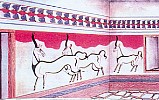
Ivy leaves and
Hearts above
antelopes |
|
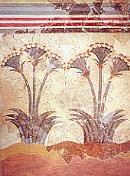
House of
the Ladies:
The Papyrus Fresco with
horizontal lines above
symbolizing the snake. |
|

The
River-dragon fresco above the
ship procession. |
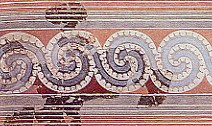
Spirals
with fins above the
fresco of the blue
monkey |
The
'Ivy Leaf' and the
'Snake'
|
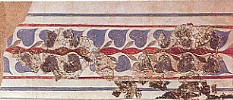
Upper
frieze above 'the boxing
children' and the antelopes
fresco. Above and below a
central horizontal stem
'hearts' and 'ivy leaves'. The
stem widens and narrows like
the spine of a snake. The ivy
leaves symbolize it's head and
tail. The widening and
narrowing pattern is also
found on a vase in the museum
in Paros, on a diadem from
Alexandria and on a Neolithic
Chinese vessel. |
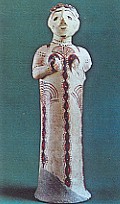
Mycenaean
idol in the Museum of
Nafplion. The widening and
narrowing pattern as stem of a
stylized flower and the dots
symbolizing the snake. |
|

Fragment of a gold diadem
from Alexandria now in the
Benaki Museum in
Athens.
|
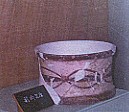
Clay
Neolithic
vessel in the
museum of
Henan in
China |

Neolithic
clay vase from Saliagos(tiny
island near Paros).
4th Millennium.
Paros
Museum |
|
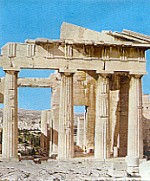
The
Propelea of the Acropolis of
Athens. A band of snake skin
(metopes and triglyphs) above
the columns for keeping out
evil. |
|
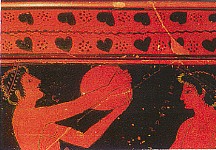
Detail of
a 500 BC red figure Attic cup
in Berlin's Antiken Museum
with snake (undulating line
and ivy leaves) and
lotus. |
Spirals with
Snake Head:
Hearts on Doors and Windows for Keeping Away
Evil
|
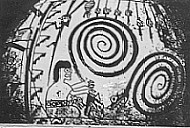
Mochicha
Art from northern Peru with
spirals ending in snake
heads |
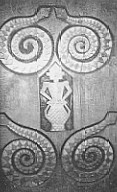
Sculptured door of the Paiwan
aborigines of Taiwan |

On the girl's t-shirt is a
spiral and inside a heart-head
of a snake |
|
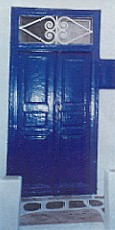
A blue door and spiral hearts
symbols in Mykonos,
Greece |
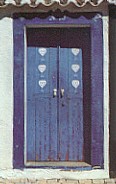
Little hearts on a blue door
in Cascais, Portugal |
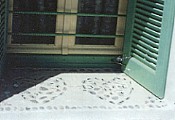
Hearts made of pebbles on the
sill of a window to keep evil
from entering this house in
Tholaria, Amorgos |
'Ivy Leaf' or
the Head of a Cobra
|
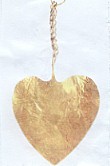
Gold 'ivy leaf' from 2000 BC
in the Mitsotakis
collection |

Gold gilt silver 'ivy leaf'
350 BC from Macedonia in the
Aiani Museum |
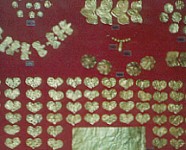
1500 BC Gold ornaments with
holes for attachments on robes
from the tholos tomb of
Kapakli in nea Ionia near
Volos now in the Athens
Archaeological Museum |
|

North
American Indian with snake
heads painted on his
cheeks. |
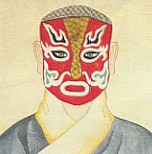
Mask of the Peking Opera with
leaves on the cheeks from the
Berlin Volkerskunde
Museum |
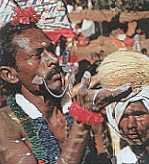
Kataragama
festival in Sri Lanka. On his
cheeks are silver ivy
leaves |
|
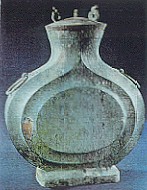
Bronze
Chinese wine vessel of the
Warring States Period with ivy
leaf design |
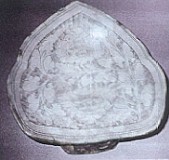
Porcelain Ming Dynasty
'pillow' from the Cernuschi
Museum in Paris |
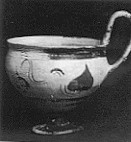
Clay Mycenaean cup with an
ivy leaf with a double stem,
in fact a snake from the
Museum of Thebes |
The Snake
(Heart) on Gospels and on Fer forge
|
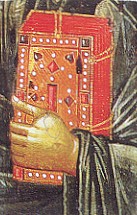
The hand of Jesus holding a
gospel decorated with hearts.
Detail of a wooden icon from
about 1380, from the church of
St. Nicholas at Kastoria, now
in the Byzantine Museum of
Kastoria |

Christ is holding snake
symbol (metopes, triglyphs and
hearts). The emblem of St.
Catherine's monastery in Sinai
is the heart. |

Achilles and the queen of the
Amazons. On his shield are
hearts on each side of a wavy
line which signifies the
snake. Circa 500 BC now in the
British Museum. |
|
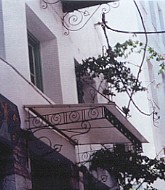
Ploymiste tourist shop on the
island of Skopelos near the
harbor. The fer forge of the
balcony is from the original
building built in the early
1900's. The metal work over
the door came from the old OTE
building before it was
destroyed. Metopes with
triglyphs (two vertical lines)
and 'ivy leaves' or
heart-snake heads |

The snake of
Aesculapius |
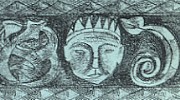
The snake-ancestor of the
aborigines of Taiwan |
Maenads and
Snakes
Is the Ivy Leaf or Heart Symbolizing the
Snake?
|
Maenads are
often depicted with snakes on
their heads or holding them. The
two maenads of the vase from Paris
(below left) are holding the
snakes from around the neck so
that they won't be bitten. The
body of the snake is formed on
both sides by a wavy line which is
it's spine and the hearts or 'ivy
leaves'. |
|
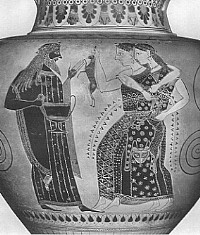
Dionysos and Maenads on a
black figured vase from
Cabinet des Medailles in
Paris |
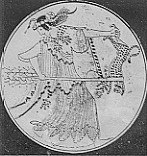
Kylix from Vulci. The Maenad
has a snake on her head and
her strysos (staff) consists
of 'ivy leaves' with
dots. |
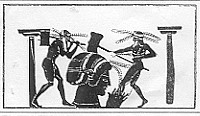
A 6th Century BC
representation of Pandora. The
Selinus that forged her are
usually shown with snakes on
their heads and snakes come
out of the head of
Pandora. |
|
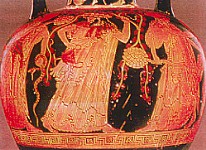
Dionysos and the Maenads.
Detail of a red figured vase.
The god wears a wreath with
'ivy leaves'. One Maenad is
holding a snake and the other
has a thyrsos formed by 'ivy
leaves'. The shaft is not
straight but waves like a
snake. |
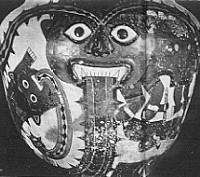
Huari vase
from Peru. Snakes coming out
of the mouth and foreheads of
wild cats. |
Was 'The
prince of the Lilies' a Shaman Holding a
Snake?
|
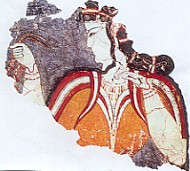
Fresco from Mycenae of a
dancer with her hair in the
air holding a snake with her
right hand from the Athens
Archaeological museum. |
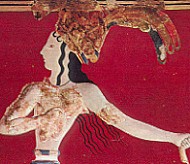
'Prince of the Lilies'.
Detail of a wall painting from
the Palace of Knossos with his
left hand and fingers closed
in the same way as if he were
also holding a snake.
Fragments resembling a snake
can be seen. From the
Heraklion Museum in
Crete. |
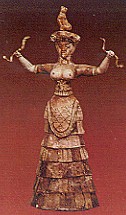
"The Goddess of the Snakes"
holding snakes from the middle
of the body. Ivory statuette
from Knossos in the Heraklion
Museum. |
|

Chinese Mythological figure
with snakes coming out of his
head and holding them from the
middle of their body like the
Cretan Goddess. |
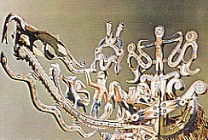
Prow decoration of an African
canoe from Duala. The shaman
holds the snakes from the neck
as in most cases. |
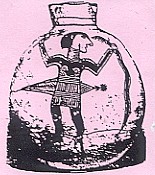
Clay vase from Cyprus from
around 500 BC. The figure is
holding a snake while getting
ready to hit it with a double
axe in his right hand. |
|
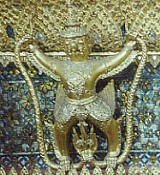
"Garouda' from the Temple of
the Emerald Buddha (1782)
Bangkok, the old
Palace. |
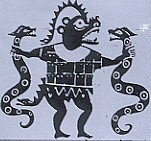
Art Mochicha from Northern
Peru.
A snake comes out of the
forehead of the figure
with a snake tail. As usual
he is holding two snakes by
the neck. |
|
Rings, Fans and Diamonds in
Heart and Pear Shapes
|
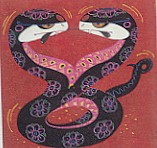
Double headed cobra decorated with lotus from
a Chinese children's book. Cobras are kissing
while making love. |
|

Ring from India with 'pears' or
heads of kissing cobras. |
|

Ring of Saint Catherine's
monastery in Sinai. |
|
|

Indian ring |
|

Algida Ice-cream logo |
|
|
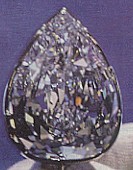
Diamond in 'pear' shape |
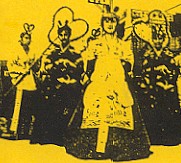
Korean 'heart' shaped faces and
hairdos |
|

The emblem of the Medical center
of Athens |
|

Drawing of the design of American
ring with twin hearts with snakes
on each heart. |
|
|

India. 'Hearts' on the fabric which covers
the elephant |
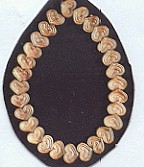
Myceneaen gold necklace similar to those of
American Indians. From the Archaeological
Museum of Thebes. |

For protection against thieves, wallets,
purses and locks had snake symbolism. |
The Heart-Triangular (Snake)
Face
|
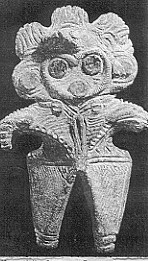
Heart shaped face. Japan. First Melinium BC.
Typical of prehistoric Japanese
sculpture |
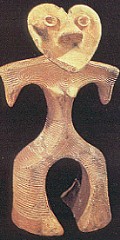
Clay statuette from Japan with heart shaped
face. |
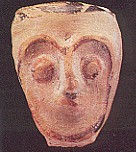
Mycenaean clay head from Kozani, Macedonia,
second half of the second millennium BC. Aeni
Museum |
|
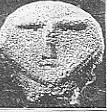
Head with pointed chin from 3000 BC Cyprus.
The eyes and nose for a T which is the
symbolic representation of the snake. |
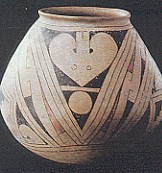
Clay Vessel from Chihuahua New Mexico from
between 850-1335 AD. The traditional pattern
is the head of the snake protector. |

Human head with snake body painted on clay
from Han Dynasty China |
|
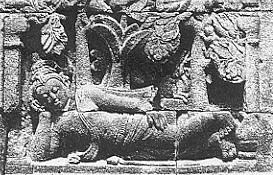
Sleeping Buddha from Borubudur from about 800
AD. |

Snake with woman's head from
Mytilini,(Lesvos) in the Athens Byzantine
Museum. On the back of the tail is a lotus
flower. |
Lime Painted Symbolic Patterns
of Protection Outside Houses in the Cyclades and India
|
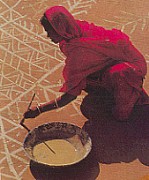
In Rajastan, northern India, women decorate
their yards with traditional symbolic patterns
of the original man. |
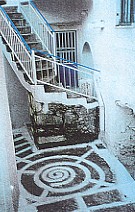
In Kynidaros on the island of Naxos (the
mountainous village of my grandmother). The
big spiral outside the door, the zig-zag of
the surrounding wall and the blue color will
keep evil away. |
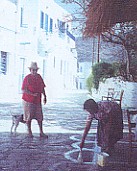
Langada on the island of Amorgos. Every year
on the festival day of the village, the roads
are painted with the old symbolic
patterns. |
|
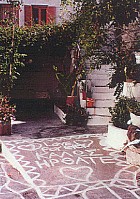
Island of Paros |

Hearts from Amorgos |
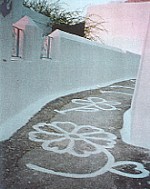
Flowers and leaves in the shapes of hearts
from Amorgos |
|





